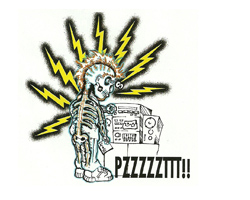
Cable Shielding. It is often desirable to protect cables from three forms of interference.
They include audio frequency electric fields, radio frequency (RF) electromagnetic fields, and audio-frequency magnetic fields.
Strong AC electric fields (often improperly called electrostatic fields) radiate from any conductor operating at a high AC voltage, such as a neon sign.
As shown in Figure 4, surrounding a signal conductor with a grounded conductive “shield” of copper or aluminum will prevent such coupling.
Electric fields are generally a problem only when the driving source has a high output impedance, as with some vacuum-tube audio gear. The same kind of shielding is used to prevent RF interference, such as from broadcast stations or wireless devices.
Unlike balanced interfaces, unbalanced ones cannot nullify the effects of interference induced in the cable by AC magnetic fields. Cable shielding made of copper or aluminum has no significant effect on audio frequency magnetic fields.
Only materials with high magnetic permeability, such as steel or other magnetic alloys, can reduce the effects of AC fields generated by power transformers, high-power AC power wiring, or CRT displays. Because magnetic field strength falls off rapidly with distance from the source, re-routing signal cables is usually the most effective solution.

Cable Hype. No other product is as shrouded in hype and mystery as the audio cable. The audio industry abounds with misinformation, myth, and mysticism. Scientific double-blind tests have shown that there is nothing unexplainable about audible differences among cables – when the differences can be demonstrated to truly exist.
For example, the physical design of a cable is known to affect its coupling of ultrasonic power line noise. Even very low levels of this noise can cause audible “spectral contamination” in downstream amplifiers.
The real solution to this problem is to prevent the coupling in the first place, rather than agonize over which “designer cable” makes the most pleasing improvement. Marketing hype for exotic audio cables often invokes classic transmission line theory and implies that nanosecond response is somehow important.
Just remember this: Real physics reminds us that audio cables exhibit no significant transmission-line effects in the engineering sense until they are about 4,000-feet long.
In engineering terms, a high-performance cable for unbalanced audio should have low capacitance and very low shield resistance. A good example of such a cable is Belden 8241F. Its 17 pF (per foot) capacitance allows driving a 200-foot run from a typical 1 k consumer output while maintaining a 3 dB bandwidth of 50 kHz.
It’s low 2.6-meter per foot shield resistance is equivalent to number 14 gauge wire, which can significantly reduce common-impedance coupling. It’s also quite flexible and available in many colors.
Expensive and exotic cables, even if double- or triple-shielded, made of 100 percent pure “unobtainium” and handmade by a team of virgins have NO significant effect on hum and buzz problems!
Bill Whitlock has served as president of Jensen Transformers for 20 years and is recognized as one of the foremost technical writers in professional audio.
